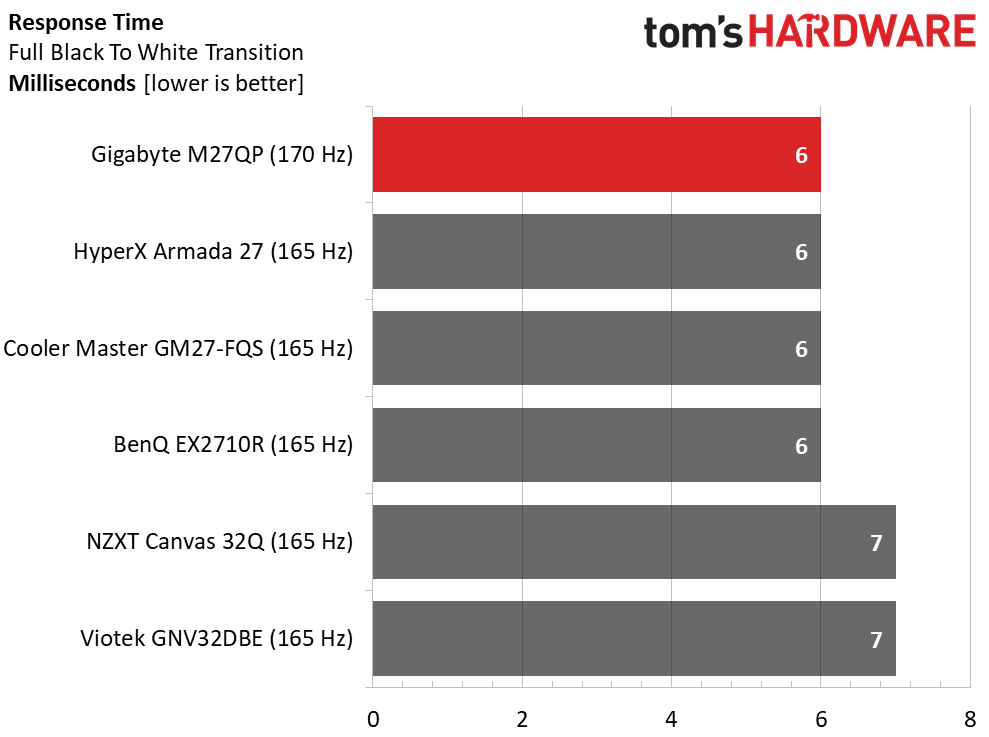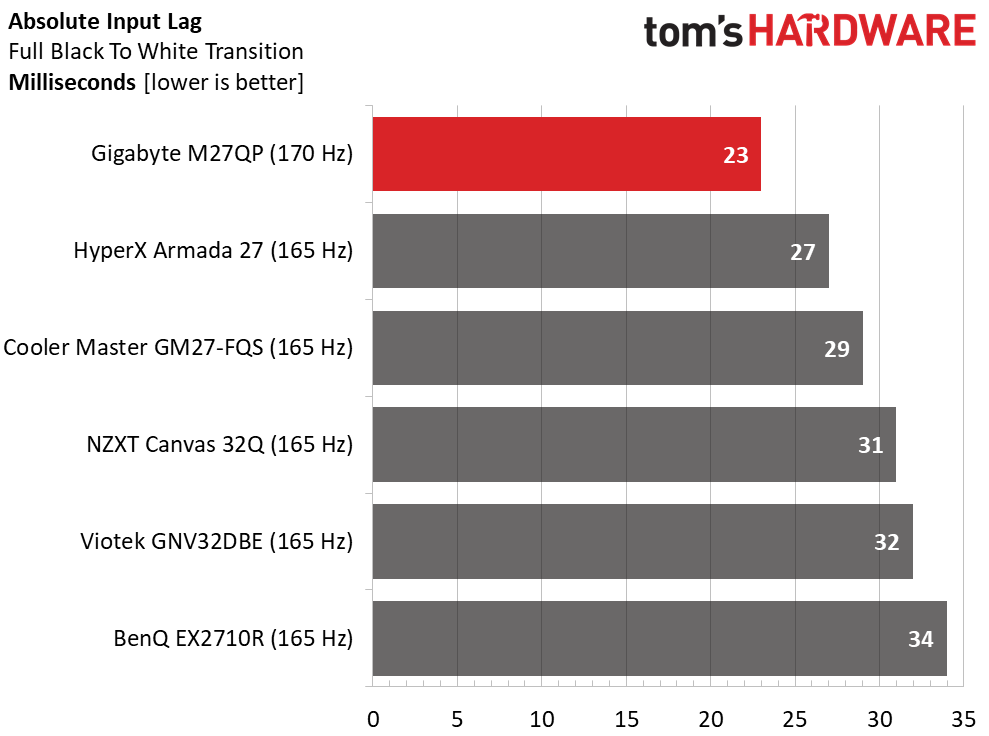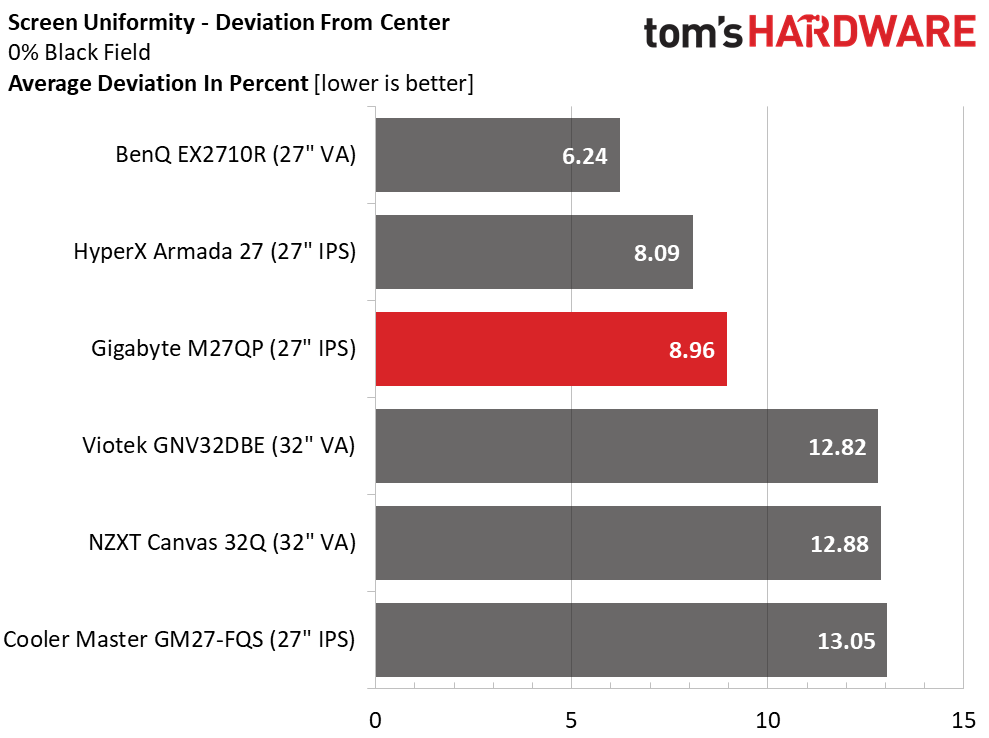Why you can trust Tom's Hardware
Though the M27QP can run at 170 Hz, nearly all monitors in this category run at 165. The difference is minute; motion resolution comparisons come down to the quality of a display’s overdrive. For this review, I’ve included the HyperX Armada 27, Cooler Master GM27-FQS, BenQ EX2710R, NZXT Canvas 32Q and Viotek GNV32DBE. All are QHD resolution in either 27 or 32-inch sizes.
Pixel Response and Input Lag
Click here to read up on our pixel response and input lag testing procedures.


6ms is the typical time for a 165 or 170 Hz panel to draw a full white field from top to bottom. The M27QP adds a very competent overdrive to the mix for superb motion resolution and smooth operation. It also sets itself apart by allowing the backlight strobe (Aim Stabilizer Sync) to work with Adaptive-Sync. This gives the user another option.
The M27QP moves further ahead of the pack in the total lag test with a score that puts it within striking distance of a 240 Hz monitor. While it won’t quite deliver the motion clarity associated with that refresh rate, it is a viable competition tool for skilled players.
Viewing Angles
The M27QP uses a premium IPS panel, as evidenced by its excellent off-axis image quality. At 45 degrees to the sides, there is no reduction in light output, only a slightly cool tint which will be hard to see in actual content. Shadow detail also remains clear at this angle. The tint goes red/green from the top, and light is reduced. However, clarity is better than most other monitors from this view.
Screen Uniformity
To learn how we measure screen uniformity, click here.
My M27QP sample had no visible issues when displaying and measuring a black field pattern. There are no signs of glow or bleed anywhere on the screen. Brighter fields are equally uniform with no variation in either luminance or color.
Get Tom's Hardware's best news and in-depth reviews, straight to your inbox.
MORE: Best Gaming Monitors
MORE: How We Test PC Monitors
MORE: How to Buy a PC Monitor: A 2022 Guide
MORE: How to Choose the Best HDR Monitor
Current page: Response, Input Lag, Viewing Angles and Uniformity
Prev Page Features and Specifications Next Page Brightness and Contrast
Christian Eberle is a Contributing Editor for Tom's Hardware US. He's a veteran reviewer of A/V equipment, specializing in monitors. Christian began his obsession with tech when he built his first PC in 1991, a 286 running DOS 3.0 at a blazing 12MHz. In 2006, he undertook training from the Imaging Science Foundation in video calibration and testing and thus started a passion for precise imaging that persists to this day. He is also a professional musician with a degree from the New England Conservatory as a classical bassoonist which he used to good effect as a performer with the West Point Army Band from 1987 to 2013. He enjoys watching movies and listening to high-end audio in his custom-built home theater and can be seen riding trails near his home on a race-ready ICE VTX recumbent trike. Christian enjoys the endless summer in Florida where he lives with his wife and Chihuahua and plays with orchestras around the state.
-
truerock In 2012 I built a PC with an nVidia GeForce GTX 690 video card.Reply
USB 3.0, PCIe 3.0, SATA III, DDR3 memory, 120GB SSD, etc.
It runs a 27" monitor at 1080p, 8-bits, 60Hz.
I can't believe PCs have advanced so little in 10 and 1/2 years.
I guess when PCs have moved up to USB 4 and PCIe 4, DDR 4... I'll be ready to upgrade.
If it will run a 4k, 10-bits, 120Hz monitor (80 Gb/s).
I guess that will be in 2024? 2025? I hope I don't have to wait until 2026. -
SyCoREAPER Replytruerock said:In 2012 I built a PC with an nVidia GeForce GTX 690 video card.
USB 3.0, PCIe 3.0, SATA III, DDR3 memory, 120GB SSD, etc.
It runs a 27" monitor at 1080p, 8-bits, 60Hz.
I can't believe PCs have advanced so little in 10 and 1/2 years.
I guess when PCs have moved up to USB 4 and PCIe 4, DDR 4... I'll be ready to upgrade.
If it will run a 4k, 10-bits, 120Hz monitor (80 Gb/s).
I guess that will be in 2024? 2025? I hope I don't have to wait until 2026.
What on earth are you rambling about? None of what you said has any relevance to this monitor.
Can I call you a cab to take you home? -
truerock Replysycoreaper said:What on earth are you rambling about? None of what you said has any relevance to this monitor.
Can I call you a cab to take you home?
Fair point... I guess it was off topic.
My "ramble" was trying to say, "170Hz QHD... so what". I was trying to put that in context. -
SyCoREAPER Replytruerock said:Fair point... I guess it was off topic.
My "ramble" was trying to say, "170Hz QHD... so what". I was trying to put that in context.
Makes more sense.
The 170hz is the big deal. It wasn't until fairly recent that monitors moved above 144hz which was a big deal. IIRC there are monitors that go above that but you are getting into build multiple computers for the price territory.
As for resolutions, 4K isn't really that prevalent, at least not with high refresh rate and affordable prices mainly because most cards until this Gen simply could barely get triple digits at 1440 in AAA titles. -
truerock Replysycoreaper said:Makes more sense.
The 170hz is the big deal. It wasn't until fairly recent that monitors moved above 144hz which was a big deal. IIRC there are monitors that go above that but you are getting into build multiple computers for the price territory.
As for resolutions, 4K isn't really that prevalent, at least not with high refresh rate and affordable prices mainly because most cards until this Gen simply could barely get triple digits at 1440 in AAA titles.
I absolutely agree with you.
I'm expressing an emotional impatience with how slowly PC technology has advanced over the last 10 years.
I'm kind of the opposite of a lot of people who want future technology to support old technology standards.
I think Apple is good at getting rid of the old and moving more quickly to new technology.
I occasionally will attach a 4k Samsung TV to my 10-year-old PC just to get a feel of the experience. It is very cool. Unfortunately, on my 10-year-old PC 4k-video runs at 30Hz, 8-bit.
Oh... I just rambled aimlessly again... my bad. -
SyCoREAPER Replytruerock said:I absolutely agree with you.
I'm expressing an emotional impatience with how slowly PC technology has advanced over the last 10 years.
I'm kind of the opposite of a lot of people who want future technology to support old technology standards.
I think Apple is good at getting rid of the old and moving more quickly to new technology.
I occasionally will attach a 4k Samsung TV to my 10-year-old PC just to get a feel of the experience. It is very cool. Unfortunately, on my 10-year-old PC 4k-video runs at 30Hz, 8-bit.
Oh... I just rambled aimlessly again... my bad.
Moore's Law is dead, has been for a while unfortunately. -
Wimpers Replysycoreaper said:Moore's Law is dead, has been for a while unfortunately.
What did you expect? We can't keep cramming more and more transistors on the same space and/or ramp up the frequency, there actually are physical constraints to about everything.
We haven't reached them yet when it comes to storage capacity and perhaps memory and network or bus speeds but for a lot of other things only parallelisation is an option but this is not possible everywhere and sometime requires a redesign and adds some overhead. -
SyCoREAPER ReplyWimpers said:What did you expect? We can't keep cramming more and more transistors on the same space and/or ramp up the frequency, there actually are physical constraints to about everything.
We haven't reached them yet when it comes to storage capacity and perhaps memory and network or bus speeds but for a lot of other things only parallelisation is an option but this is not possible everywhere and sometime requires a redesign and adds some overhead.
Congrats?
I know that, I was explaining to OP why he feels that PC components haven't evolved further than they thought by now.

